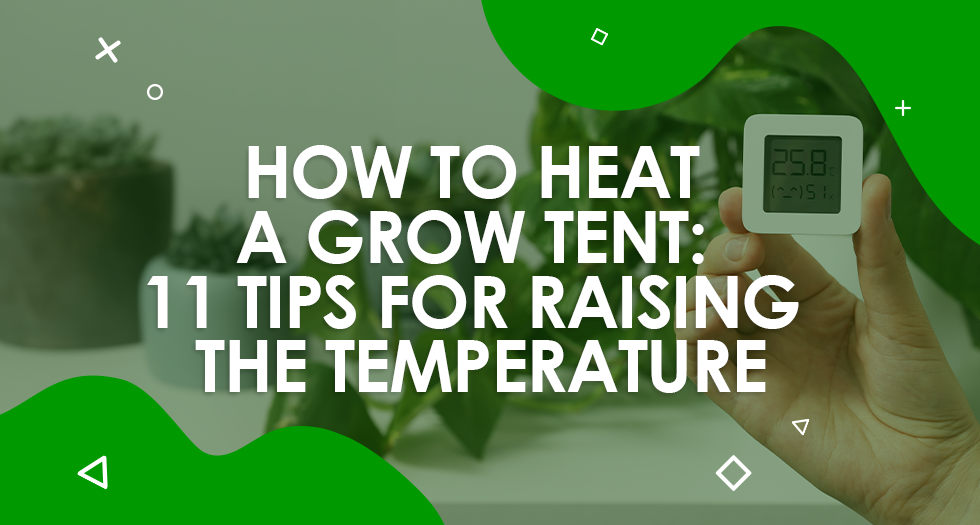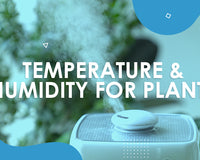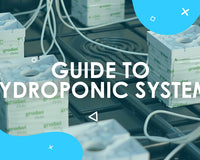Temperature plays an important role in the growth and development of plants. Maintaining the temperature of a grow tent at optimal levels will help your plants thrive and promote bigger harvests. As we move into the cooler months of winter, cultivating plants indoors can become more challenging. If plants become too cold, the rate of development will slow, affecting overall development, and delaying fruiting and flowering. Furthermore, sudden drops in temperature can cause stress, root damage, and result in plant decline. In this guide, we explore how to heat a grow tent and the different ways you can manage temperature in the grow space.
Monitor Grow Tent Temperature
The first step is to monitor the temperature in your grow tent and determine the exact climate your plants require for optimum growth. If you are not sure what temperature your plants need to thrive, you should check the seed packet or refer to horticultural literature and plant guides. Alternatively, check out our blog on ideal temperature and humidity.
Regular temperature monitoring will not only provide you with an exact reading but will also tell you if changes to your grow equipment are impacting the climate. For example, if you introduce a new lighting system that omits more or less heat, or change your ventilation set up, you will know right away if the changes have impacted your grow space.
Monitoring the temperature in the grow room is easy with the correct equipment. So, whether you’re a beginner or seasoned indoor farmer, there is a solution for you. At the lower end of the scale there are traditional mercury thermometers and digital thermometers with integrated hygrometers.
If you need to monitor temperature remotely (which is highly recommended), there’s a range of options. Sensors that send data to mobile apps like the AirComfort Temperature & Humidity Sensor are ideal for remote monitoring on the go.
For professional indoor farmers, sophisticated climate automation equipment with temperature sensors, such as the TrolMaster Thermostat Station trigger climate control equipment when levels rise or fall outside of the ideal temperature range.
How to Raise the Temperature in a Grow Tent
Raising the temperature in a grow tent can be achieved in a number of ways. For example:
-
Adjust the central heating: If the building has central heating, simply adjusting the temperature in the room where your grow tent is located can help increase the ambient room temperature.
-
Portable space heaters: Investing in portable heaters to place inside the grow space are a quick and efficient way to boost the temperature. Options range from simple oil filled radiators with built in thermostats, to fan heaters.
Fan heaters can be expensive to run and can dry air out, causing a lowering of humidity. As a result, we don’t recommend placing a fan heater directly inside a grow tent. Instead use it to warm the air in the room where the grow tent is located.
-
Tube Heaters: Tube heaters are another convenient and easy to install solution. The Lighthouse ECOHEAT Tube Heater, for example, is a cost-effective way to protect your plants from temperature drops. Mounted to the wall or floor, these energy efficient heating tubes can be set up to provide a consistent heat output. Alternatively, they can be connected to a thermostat so that it kicks in when the temperature drops below your ideal temperature range.
-
Insulation: Poor insulation allows heat to leak out of the grow space. Ensuring your tent is well insulated will keep the heat in and the cold out. Check for any gaps and seal with appropriate material to prevent heat escaping.
-
Reflective sheeting: Reflective sheeting increases diffusion and reflection inside the grow room. Heat dispersal is optimised as light bounces off the surface to create a warmer environment.
-
Optimise lighting for heat distribution: High intensity grow lights such as metal halide and high pressure sodium lamps generate more heat than less energy hungry LEDs. Ensuring HID lamps are positioned to distribute heat evenly across the tent should help maintain temperatures and increase heat production in your grow tent.
Increasing the amount of time your lights are on will also increase heat production. However, care must be taken to ensure the right balance of light and darkness is maintained for the various growth stages.
-
Slow the rate of air exchange: Slowing down the rate of air exchange can help raise humidity and warmth. Operating the exhaust fan at a slower speed will reduce air exchange helping to keep the tent warmer. Always be mindful that it is essential to maintain a fine balance to prevent your grow tent from becoming too humid. High humidity comes with its own drawbacks such as creating the perfect environment for pests, and promoting bacterial and fungal growth.
-
Slow internal fan speed: Fans blow air around the tent which contributes to heat dissipation. Operating fans at slower speeds will promote a gentler airflow and stable temperature.
-
Change your fresh air source: If your ventilation system is drawing fresh air from outside, consider changing your set up to draw air from an internal room. Cold air takes longer to warm up, so by drawing room temperature air into the tent, your overall internal temperature will be easier to maintain.
-
Heat Mats: Heat mats are available in a range of sizes. Placed underneath the plant, they help to protect seedlings and cuttings from harsh temperature drops and encourage better root development in the early stages of a plant’s life. Ensure to use a heat mat thermostat to prevent overheating. Heat mats are not usually recommended for adult plants because mature plants are less reliant on bottom heat.
- Use a Nutrient Heater: Sudden changes in nutrient solution temperature in hydroponic systems can cause thermal shock in the root zone. When the weather is cold, using a nutrient heater will regulate nutrient temperature, promote nutrient uptake, and prevent a decline in health and irreversible damage.
Conclusion
Maintaining the ideal temperature in your grow room has many benefits. It protects your plants from sudden temperature drops and encourages optimal growth for healthier crops and bigger harvests.
Temperature affects many aspects of plant development including photosynthesis, nutrient uptake, and overall development through the different growth stages. A stable climate without temperature fluctuations can also help reduce the risk of stress and disease.
Small changes to your existing set up can make a big difference, so in many cases heating your tent may not be as costly as you think. With many cost-effective solutions to heat a grow tent, raising the temperature needn’t break the bank. If you need further advice on climate control, get in touch and we’ll be happy to help.






